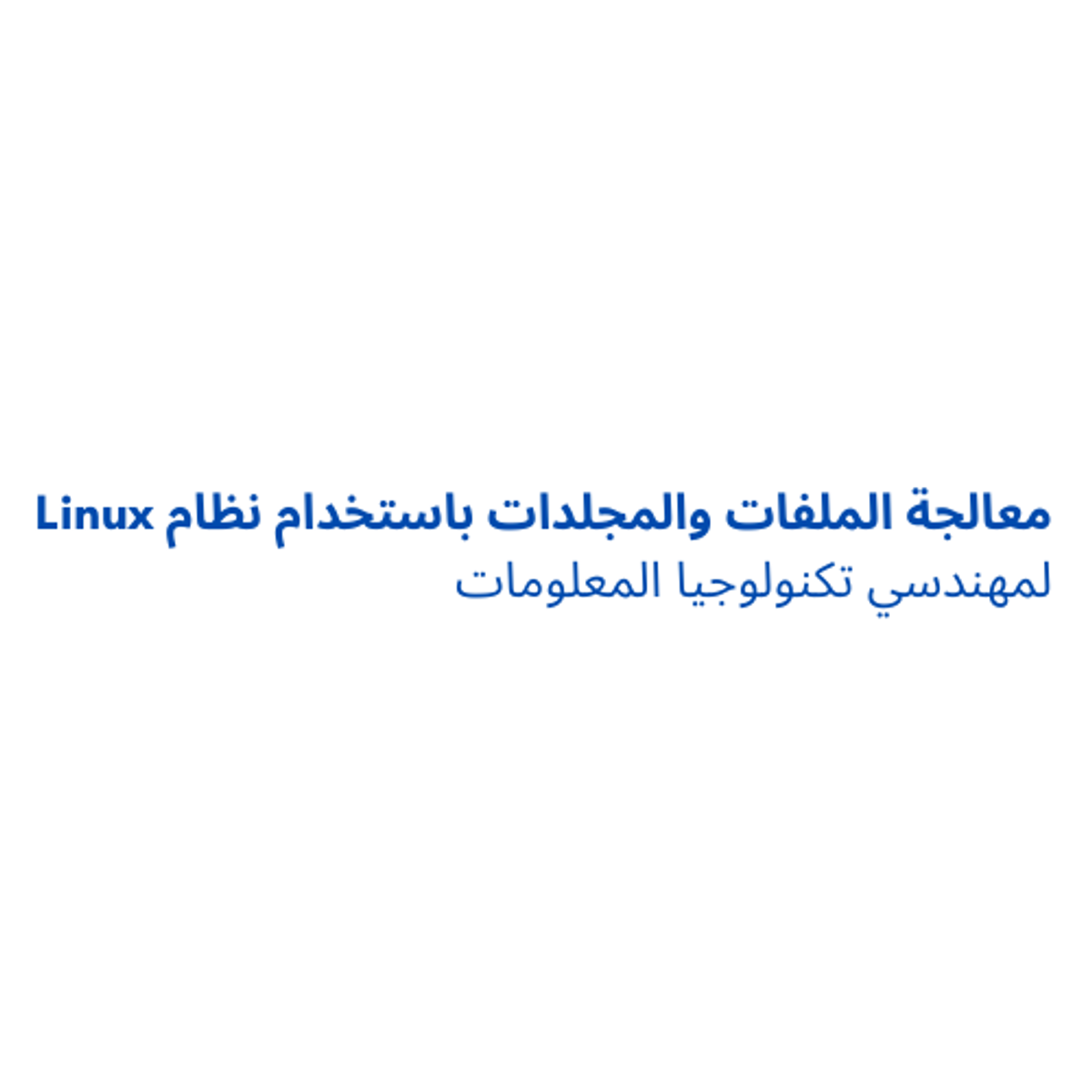
في نهاية هذا المشروع ، ستكون قادرًا على التفاعل مع أوامر Linux ، ومعرفة المسار الذي تعمل فيه وتغييره إلى أي مسار آخر عن طريق تطبيق بعض الأوامر الأساسية مثل cd و pwd. ايضا ، ستتمكن من اظهار الfolders والfiles وإنشاؤها وحذفها عبر نظام Linux الخاص بك. أخيرًا ، ستتمكن من تطبيق تقنيات مختلفة لمعالجة الملفات والمجلدات من خلال إنشائها وقراءتها ونقلها باستخدام أوامر touch وcp و mkdir و rm وأخيراً ستكون قادرًا على استخدام أوامر SED و AWK. يعتبر الterminal أكثر قوة ومرونة ومفيدًا في إنشاء عمليات قابلة للتكرار. كما أنه أقل استهلاكًا للموارد لأنه عندما تعمل مع موارد محدودة أو ترغب ببساطة في زيادة سرعتك ، فإن استخدام ال terminal سيكون دائمًا أفضل من استخدام ال graphical user interface لأن استخدام ال graphical user interface يعني أنه يجب تخصيص الموارد اكبر لـ تقديم ال graphical input .
Read more
في نهاية هذا المشروع ، ستكون قادرًا على التفاعل مع أوامر Linux ، ومعرفة المسار الذي تعمل فيه وتغييره إلى أي مسار آخر عن طريق تطبيق بعض الأوامر الأساسية مثل cd و pwd. ايضا ، ستتمكن من اظهار الfolders والfiles وإنشاؤها وحذفها عبر نظام Linux الخاص بك. أخيرًا ، ستتمكن من تطبيق تقنيات مختلفة لمعالجة الملفات والمجلدات من خلال إنشائها وقراءتها ونقلها باستخدام أوامر touch وcp و mkdir و rm وأخيراً ستكون قادرًا على استخدام أوامر SED و AWK. يعتبر الterminal أكثر قوة ومرونة ومفيدًا في إنشاء عمليات قابلة للتكرار. كما أنه أقل استهلاكًا للموارد لأنه عندما تعمل مع موارد محدودة أو ترغب ببساطة في زيادة سرعتك ، فإن استخدام ال terminal سيكون دائمًا أفضل من استخدام ال graphical user interface لأن استخدام ال graphical user interface يعني أنه يجب تخصيص الموارد اكبر لـ تقديم ال graphical input .
في نهاية هذا المشروع ، ستكون قادرًا على التفاعل مع أوامر Linux ، ومعرفة المسار الذي تعمل فيه وتغييره إلى أي مسار آخر عن طريق تطبيق بعض الأوامر الأساسية مثل cd و pwd. ايضا ، ستتمكن من اظهار الfolders والfiles وإنشاؤها وحذفها عبر نظام Linux الخاص بك. أخيرًا ، ستتمكن من تطبيق تقنيات مختلفة لمعالجة الملفات والمجلدات من خلال إنشائها وقراءتها ونقلها باستخدام أوامر touch وcp و mkdir و rm وأخيراً ستكون قادرًا على استخدام أوامر SED و AWK. يعتبر الterminal أكثر قوة ومرونة ومفيدًا في إنشاء عمليات قابلة للتكرار. كما أنه أقل استهلاكًا للموارد لأنه عندما تعمل مع موارد محدودة أو ترغب ببساطة في زيادة سرعتك ، فإن استخدام ال terminal سيكون دائمًا أفضل من استخدام ال graphical user interface لأن استخدام ال graphical user interface يعني أنه يجب تخصيص الموارد اكبر لـ تقديم ال graphical input .
-هذا المشروع الإرشادي مخصص للأشخاص المهتمين بتعلم Linux من البداية.
-المبتدئين الذين يرغبون في استخدام أوامر Linux للمهام الأساسية ولكن لا يعرفون من أين يبدأون.
-المبتدئين الذين لا يعرفون كيفية استخدام الterminal.
-الأشخاص الذين يفكرون في مهنة كمسؤول أو مهندس لنظام Linux ، لكنهم بحاجة إلى الأساسيات أولاً.
ملاحظة: تعمل هذه الدورة التدريبية بشكل أفضل للمتعلمين المقيمين في منطقة أمريكا الشمالية. نعمل حاليًا على توفير نفس التجربة في مناطق أخرى.
What's inside
Syllabus
Good to know
Save this course
Activities
Follow a tutorial on using Linux commands
Show steps
Build your confidence in using Linux commands by following a structured tutorial.
Browse courses on
Linux Commands
Show steps
-
Find a reputable tutorial on using Linux commands.
-
Follow the instructions in the tutorial.
-
Practice using the commands you learned.
Practice using Linux commands in a terminal
Show steps
Reinforce your understanding of Linux commands by practicing them regularly in a terminal.
Browse courses on
Linux Commands
Show steps
-
Open a terminal window.
-
Navigate to a directory.
-
Create a file.
-
Edit the file.
-
Save the file.
Create a project that uses Linux commands
Show steps
Demonstrate your mastery of Linux commands by creating a project that uses them to solve a problem.
Browse courses on
Linux Commands
Show steps
-
Identify a problem that can be solved using Linux commands.
-
Design a solution.
-
Implement your solution.
-
Test your solution.
-
Present your solution.
Show all three activities
Follow a tutorial on using Linux commands
Show steps
Build your confidence in using Linux commands by following a structured tutorial.
Browse courses on
Linux Commands
Show steps
- Find a reputable tutorial on using Linux commands.
- Follow the instructions in the tutorial.
- Practice using the commands you learned.
Practice using Linux commands in a terminal
Show steps
Reinforce your understanding of Linux commands by practicing them regularly in a terminal.
Browse courses on
Linux Commands
Show steps
- Open a terminal window.
- Navigate to a directory.
- Create a file.
- Edit the file.
- Save the file.
Create a project that uses Linux commands
Show steps
Demonstrate your mastery of Linux commands by creating a project that uses them to solve a problem.
Browse courses on
Linux Commands
Show steps
- Identify a problem that can be solved using Linux commands.
- Design a solution.
- Implement your solution.
- Test your solution.
- Present your solution.
Career center
Systems Administrator
IT Manager
IT Specialist
DevOps Engineer
Cybersecurity Analyst
Information Security Analyst
Network Engineer
Cloud Engineer
Technical Writer
Data Analyst
Web Developer
Database Administrator
Software Engineer
Data Scientist
UX Designer
Reading list
Share
Similar courses
OpenCourser helps millions of learners each year. People visit us to learn workspace skills, ace their exams, and nurture their curiosity.
Our extensive catalog contains over 50,000 courses and twice as many books. Browse by search, by topic, or even by career interests. We'll match you to the right resources quickly.
Find this site helpful? Tell a friend about us.
We're supported by our community of learners. When you purchase or subscribe to courses and programs or purchase books, we may earn a commission from our partners.
Your purchases help us maintain our catalog and keep our servers humming without ads.
Thank you for supporting OpenCourser.



